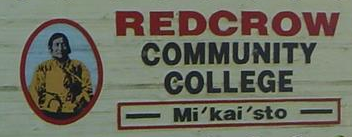Kiníí – Rosa sp. (Tomato flower; Wild tomatoes, Disposed of gut)
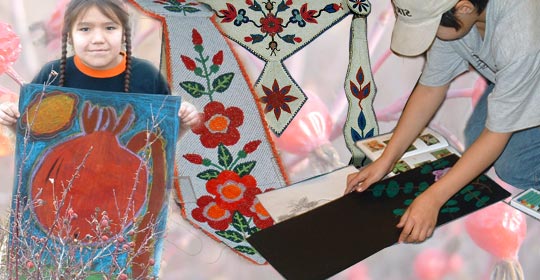
Marvin holds a pastel drawing of a Wild Rose bud and Shelby draws the Wild Rose flower.
(Glenbow Museum. (2005). Nitsitapiisinni Exhibit. Calgary, Alberta: Blackfoot Gallery Committee)
Wild Rosehips and Coyote by Noah
I remember the story about Coyote that you told me. Once Coyote was walking around. Da de da de da…
Then he heard a voice say, “Eat me. Eat me. Eat me.” Then Coyote said, “Where is that voice coming from? That little voice?” Then he looked all over and then he saw a flower. It said, “Eat me, eat me, eat me.” Then Coyote said, “I can’t eat a flower. I don’t eat those.” “Well, there is much, much here. There’s berries.” “Hmmm,” Coyote said. Coyote didn’t trust it. Then Coyote picked one. He was going to eat it. Then he ate it. “Mmmm there’s lots of seeds in here.” He liked it. Then he saw another berry. It said, “Eat me, eat me. But I gotta warn you. Only pick under 5, not lots.” Then Coyote said, “O.K.” Then Coyote started to grab lots of berries helping himself. “Da de da de da de da…” He was eating them all until his belly was dragging all over the ground. Coyote said, “Ah, I don’t feel good.” Then his bottom started to itch, itchy. He started to have to go to the washroom. Back and forth, back and forth. He was itching and itching on his bottom. Then he had the diarrheas. So remember Coyote has to learn lessons. So always pick under 5. Don’t pick more than under 5.
Wild Rose
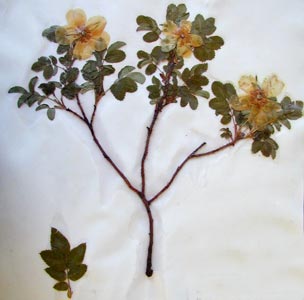
Rosa sp.
Carolla Calf Robe
Wild rose bushes grow on the open prairie,in uncultivated fields and along roads.It grows to be about 30- 120 cm high. The smooth,green, shiny leaves look pretty with the pink flowers that bloom from May to August. When the petals fall away, a red globe shaped berry appears that is about 12 mm in diameter. The berry is called a rose hip and has lots and lots of seeds. Watch for the tiny thorns on the branches when you pick the rose hips!
The berries (called rose hips) can be eaten fresh or dried to use later on. Our elders picked fresh rose hips, boiled them up and added a bit of flour to make a kind of pudding. They also mixed rose hips with fat and dried meat as an energy bar for use in the winter. A treat for children was to suck on frozen rose hips, rather like a Popsicle. Eating a rose hip tastes good and it can also help with muscle pains.
Rose hips brewed with some mint makes a very good tea that is full of vitamins, especially Vitamin C, and beta-carotene. This tea helps to soothe sore throats or a sore stomach and diarrhea.
A bitter tea can be made from the roots which also helps with diarrhea, sore stomachs and worms.
A mush of rose hips is good to heal boils, bug bites and other skin troubles. Our elders used this remedy long ago and now beauty product companies are using rose hips to make creams to soothe-troubled skin.
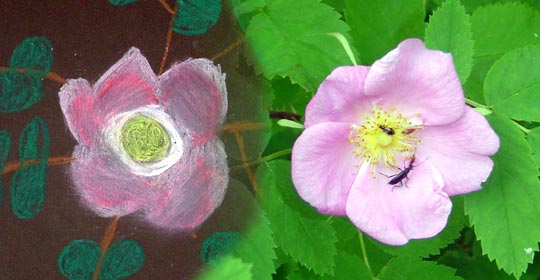
Shelby’s interpretation of the Wild Rose flower in pastel.
Rosier aciculaire
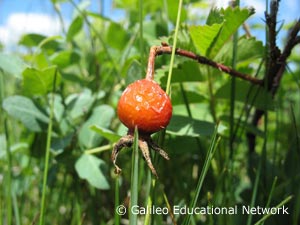
Rosa sp.
Galileo Educational Network
Le rosier aciculaire pousse dans la prairie, dans les terres non cultivées et en bordure de route. Il mesure environ entre 30 et 120 centimètres de haut. Ses feuilles lisses, vertes et brillantes sont belles lorsque les fleurs roses sortent de mai à août. Quand les pétales tombent, une baie ronde et rouge d’environ 12 millimètres de diamètre apparaît. Cette baie, qui renferme une très grande quantité de graines, s’appelle “cynorrhodon”. Il faut toutefois faire attention aux petites épines des branches quand nous les cueillons!
Ces baies peuvent se manger fraîches ou séchées. Nos aînés cueillaient les cynorrhodons, les faisaient bouillir et y ajoutaient un peu de farine pour faire un genre de pouding. Ils mélangeaient aussi les baies avec du gras et de la viande séchée pour avoir une source d’énergie pendant l’hiver. Les enfants adoraient sucer les cynorrhodons congelés, un peu comme une sucette glacée. Les baies du rosier ont bon goût. Aussi, elles aident à soulager les douleurs musculaires.
Mélangé à la menthe, le cynorrhodon permet de donner un bon thé bourré de vitamines, surtout de la vitamine C et du bêtacarotène. Ce thé soulage les maux de gorge, les maux d’estomac et la diarrhée. Il est aussi possible de faire du thé plus amer à partir des racines de cette plante pour soulager la diarrhée, les troubles d’estomac et l’hémonchus.
La bouillie de cynorrhodons permet de guérir les clous, les piqûres d’insectes et d’autres troubles cutanés. Il y a très longtemps, nos aînés se servaient de ce remède et maintenant, les entreprises de produits de beauté recourent aux cynorrhodons pour faire des crèmes apaisant les troubles cutanés.
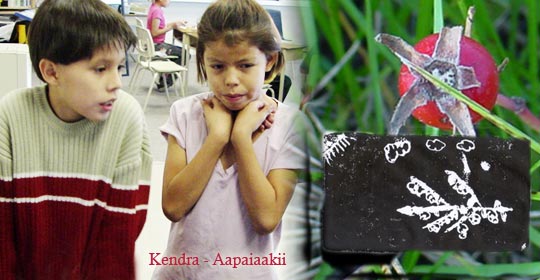
This is an original composition by student Kendra Day Rider (Aapaiaakii).
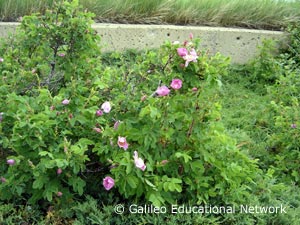
Rosa sp.
Galileo Educational Network
- Kerik, Joan. (1979). Living With The Land: Use of Plants by the Native People Of Alberta. Edmonton, Alberta: Provincial Museum of Alberta.
- Vance, F.R., Jowsley, J.R. & Mclean, J.S. (1984). Wildflowers Across The Prairies. Saskatoon, Saskatchewan: Western Producer Prairie Books.
- Willard, Terry. (1992). Edible and Medicinal Plants of the Rocky Mountains and Neighboring Territories. Calgary, Alberta: Wildrose College of Natural Healing.




